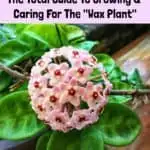
The Hoya plant, also known as a “wax plant” is native to China, Malaysia, India, Indonesia, Vietnam and are also found in the Philippines and Australia.
Hoya plants such as Hoya carnosa are known as wax plants because their leaves and flowers look like they are carved from wax.
They are evergreen perennial plants with simple leaves and roots. Leaves can be hairy or smooth and may have silvery spots. The flowers are typically green, orange, pink, red, or white. They bloom in clusters.
The maturity of the plant may affect blooming time. The conditions it is grown in can also be a factor, being things like temperature, light, and soil. Some bloom in the first years but others may take up to three years of age.
Hoyas are often sold at nurseries and grown indoors. They are sometimes used to make lotions, perfumes, powders, and other beauty products. They also remove pollutants when grown indoors.
Hoya can be grown outdoors in USDA Hardiness Zones 9-11. They can deal with temperatures that dip to 20 degrees Fahrenheit. Some consider Hoya to be easy to grow. Their stems can be trained up a trellis or trail downward in a hanging container.
Pin This To Save For Later
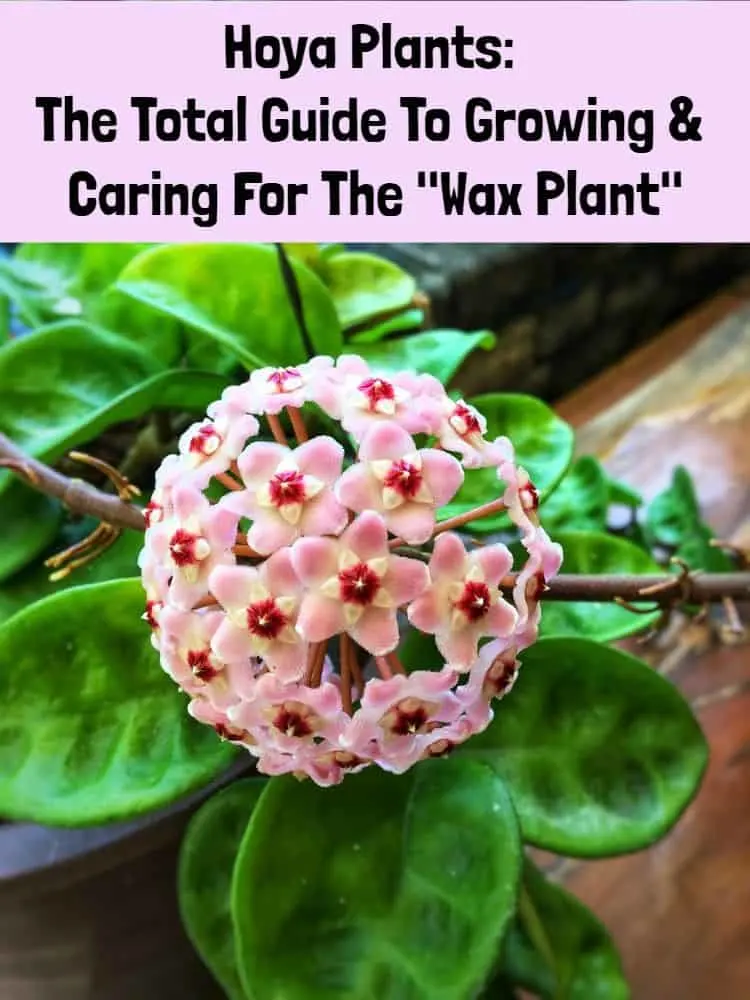
Hoya Classification
Hoyas are in a family known as Apocynaceae. They are relatives of the common milkweed (Asclepias syriaca). They have a similar flowerhead as well as sticky sap and seeds with hair.
Hoya Species
The first hoya was ascribed in 1810. There have been over 500 published with scientific names as of 2015. Many new species are discovered on a regular basis. There are likely around 700 hoya species around the world, many unnamed.
Hoyas are not the easiest plant to collect as many grow on other plants such as trees. Often new species are discovered from felled trees.
6 Popular Hoya Varieties
H. carnosa: Grows in cooler temperatures and doesn’t like to overheat. Water regularly but not overly, and keep the soil moist. Don’t let it dry out and best indirect light.
H. australis: It is easy to grow. It requires no direct sunlight and partial shade. Water regularly but don’t overwater it. Australis needs good drainage.
H. bella: Do not overwater but keep the soil moist. Do not let it dry out between waterings and keep in partial shade. It doesn’t like being root bound. Keep out of cold temperatures, It is from the rainforest and needs constant moisture.
H. curtisii: Needs humidity, dry out between waterings. Follow with a deep soak. Curisii loves the sun. Keep warm indirect light.
H. pubcalyx: Easy to care for. Do not over water but water regularly. Don’t allow it to completely dry out. Needs indirect light.
H. kerrii: Easy to care for. It needs a lot of space and prefers its soil moist. Don’t let the soil dry out, it likes the sun.
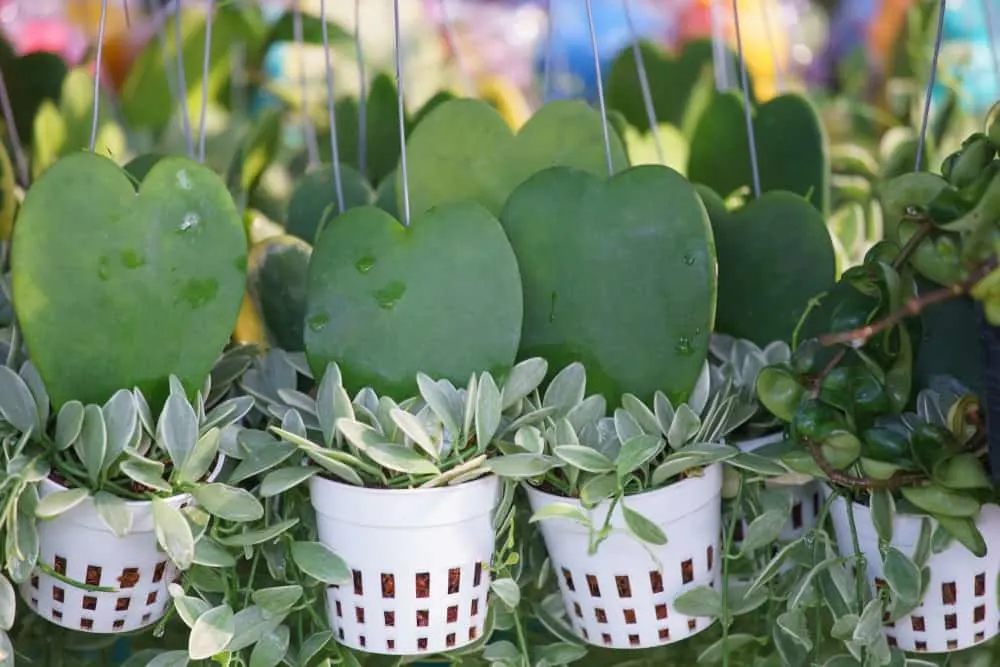
Facebook Groups You Can Join and Discuss Hoya Plants
There are many passionate growers of Hoya plants and the best places to discuss identification, growing tips and to share photos is on dedicated Facebook groups.
The Total Guide To Growing & Caring For Hoya Plants
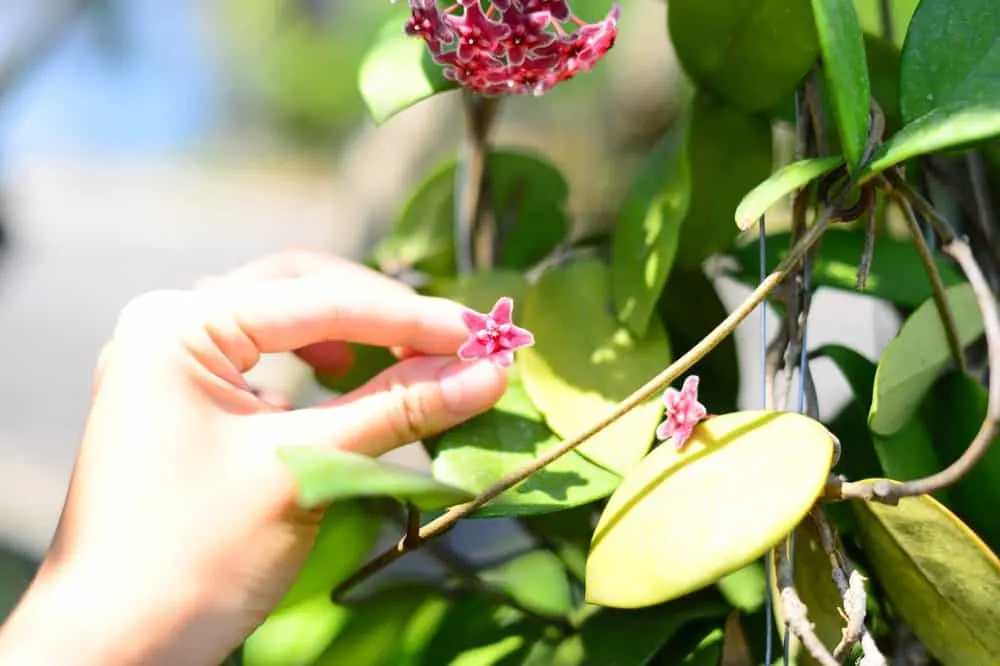
Light Requirements
Generally speaking, Hoyas do best in indirect sunlight. They will need this for between two and four hours. You could put them in a south facing window if you have enough room to do so.
If you choose to do that you should have a sheer curtain between the window and the plant to keep it from burning.
If you have an old Hoya that isn’t blooming then you should move it to a place with more appropriate lighting.
Growing Hoya Under Lights
Some types of Hoya that are semi-succulent can’t be placed in a south facing window. Their leaves might burn in the sun. Direct intense light is not always appreciated by every Hoya.
Most of these grow in gaps in the forest, or in the treetops and get dappled light. This would need to be an environment that you create in your growing space.
You may have seen hoya grown with shade cloth so that they get fifty to eighty percent shade. They need protection if this is the case.
Hoya crassicaulis, Hoya kerrii, and Hoya diversifolia can take ninety percent full sun but would prefer less. Some plants will get more red in their leaves such as Hoya vitellina. This can be beautiful but you can risk burning the plant.
Perhaps you live in a dark area of a home, such as a basement apartment. In that case, you can still grow many Hoya without natural light.
High output t-5 fixtures will be enough for most Hoya. The tubes use 54 watts each. They can be hung overhead or mounted on a wall.
Most Hoya would like at least supplemental lighting to grow in the home. The fixtures are more expensive up front but they are much longer lasting than a regular bulb. Large compact fluorescent bulbs, HO t-5 fluorescents, or HID lighting will be good for growing Hoyas without any other lighting.
Water Requirements
You should water Hoya when the soil becomes completely dry although this can depend on which type of Hoya you are growing.
They prefer room temperature water that has been allowed to sit for a day or two. Because they are tropical plants cold water can stress them. This also helps for chemicals in the water to dissipate. Chemicals that can harm plants can be found in the water.
You’ll also want to make sure that you water your plants at the beginning of the day. Moisture will then be available during daylight hours and it ensures at night the plant is dry without any wet leaves.
Pour water on the soil evenly. You’ll want to make sure the water drains out from the container. Don’t allow water to build up in the bottom of the container as it may not dry quickly and this can cause root rot.
You should also be mindful of the season. Hoya needs more water in the growing seasons of spring and summer.
The Hoya is actively growing at that time and less in the fall and winter months. If a plant drops its leaves it’s probably getting too much water. Don’t water hoyas so much when you see buds forming.
Temperature Requirements
Species that grow naturally at a higher altitude require cooler temperatures at night. However, most hoya cannot withstand chilly temps. Below fifty degrees can result in damage.
You should not order Hoya during the coldest times of the year in the northern hemisphere. You’ll have to purchase heat packs or wait for the spring. Hoya carnosa is hardy though and can withstand some drafts.
Humidity
Hoyas are accustomed to high humidity, particularly those that naturally grow in tropical places. Some even go through monsoon season, and they need heavy rainfall in parts of the year to survive.
The Hoya varieties that are more succulent are less finicky with less humidity. Most will do better if they are given more humidity. Some thin leaved varieties really need sixty to eighty percent humidity and need to be grown near a humidifier.
Fertilizing
Hoyas need a balanced water-soluble fertilizer. This would typically be a house plant fertilizer.
You’ll want to use it every four weeks in spring and summer. A good dilution rate is one teaspoon for every gallon of water but it can vary. If leaves and stems are pale, the plant needs fertilizer biweekly. If leaves are small and dark, then you can fertilize every six weeks.
Supplements
Some Hoyas can be found in areas with limestone. These plants grow better with alkaline soil.
Eggshells or oyster shells within the soil will sweeten it and make it more alkaline. Spreading them on top of the soil will suffice.
Potting Medium
There are many opinions on the potting medium for Hoyas.
Any potting mix will fail over time. They breakdown and lose their ability to hold moisture, and this can quickly cause root rot. Hoyas should be repotted every two or three years. Some even need it annually. When repotting be sure to wash off as much of the old medium as possible.
One potting medium recipe list would be perlite in four parts, then fine orchid bark in three parts added to two parts peat-based potting soil. A handful of powdered limestone and a couple of handfuls of horticultural charcoal are also added.
Epiphytic Hoyas don’t need a lot of potting medium to grow. You might see them mounted instead on a nice piece of wood, and then wrapped in Sphagnum. If this is the case you’ll need to water more frequently.
It is easier to care for Hoya in a potting medium. Hoya is grown in pure coco chips in other parts of the world such as Asia.
Generally, my potting mix is about one-third peat, one-third perlite, and one third orchid mix which is charcoal, fir bark, and perlite. This is a light mix which allows air flow. Hoya doesn’t like to be soggy, so this is a good thing. This allows them to dry out.
Repotting Hoyas
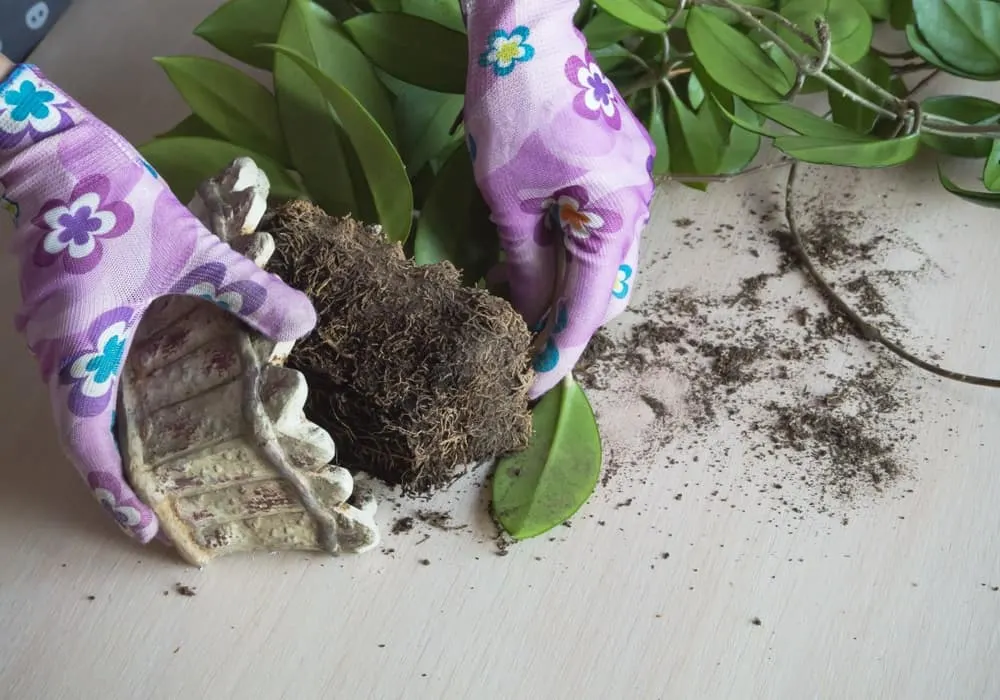
Most Hoyas don’t mind being a little rootbound, however, refresh their substrate every two to three years.
You might like to use clay pots because they are porous. This will help remove water from the potting medium. However, some growers like to grow them in clear plastic pots so they can see what is going on with the roots of the plant at all times.
When your Hoya becomes rootbound, then it’s time to repot. This encourages most Hoyas to bloom. Use pots one size higher when repotting and do not use a pot that is very large.
You’ll want to put the plant on its side and gently pull. If it is stuck, run a butter knife around the inside of the pot. This will make the roots looser.
Put your plant in the new pot. Fill with potting medium. Water the Hoya to make sure the roots settle.
Pruning Hoya
Hoya can grow to be large specimen plants over time, and you may need to prune them. Brown and dead stems can be trimmed. You might wish to grow the cuttings or even sell them.
You could also have them grow on a trellis. Latex may come out of the cut. Don’t cut the peduncle, because your plant will flower again from it. Some species will naturally lose theirs, but many do not.
Don’t remove any parts of the plant when the flower bloom is spent. You’ll get flowers again on those again during the next bloom your plant has. In addition, don’t change the location of the Hoya or move it after it begins to get buds. The Hoya might drop the buds from the stress of being moved.
Related Reading: How To Prune Jade To Get A Big Bushy Plant
Propagating Hoya
You can propagate Hoya almost exclusively from cuttings. They do have seeds on occasion but often they do not stay true to the parent plant. You can play around with seeds, but they should be clearly marked and not sold.
Try your hand at rooting these 9 Houseplants That Are Ridiculously Easy to Propagate
Rooting in Perlite
To propagate your Hoya, take good size two to six node cuttings with a sharp pruner.
Then put the base of the cutting in rooting hormone then push the cutting into some perlite right up to the bottom of the first set of leaves. You may wish to enclose the cuttings in clear plastic or put them in a dry fish tank.
You’ll want them to stay in humid conditions so that is important. Keep them warm with indirect lighting. You should place them under lights if you can, but if not just don’t put them in such direct light that the cuttings burn.
Blow carbon dioxide into the plastic bag on occasion. Remove any dropped leaves. You should have rooted cuttings in four to six weeks.
At that point, you can put them in your regular potting medium. Non-woody mature stems give the best cuttings.
Rooting in Soil
Some find it much easier to propagate their Hoya plant from cuttings directly into the soil.
Take a cutting of a mature plant and put it in a pot filled with potting medium. Trim the lower leaves. Put rooting hormone on the bottom of the cutting. Stick the cutting in the potting medium. Water it. In a couple of weeks, roots should develop.
Related Reading: 3 Easy Ways To Propagate Succulents From Leaf, Stem Or Branch Cuttings
Keeping Hoyas requires you to be knowledgeable about taking cuttings.
Most of your collection will be obtained from all over the world by getting cuttings in the mail. Sometimes if a plant is ill, the only way to save it in your collection is to take a cutting and reroot. You should attempt to master this process as an avid Hoya collector.
It’s also a great way to share and make friends with other growers.
Common Hoya Pests & Diseases
Hoya plants are relatively resistant to pests although you may find mealybug, whitefly and scale insects on your plants.
In all cases, spraying neem oil on your plants is the best form of defense.
Common Hoya Issues
Red or burnt leaves:
This is likely getting too much light. Place the plant in a more shaded area or out of direct sunlight.
Shriveled leaves:
Your plant is not getting enough humidity or water. There might be some dead roots or mealybugs. You’ll need to check the roots and determine what is happening.
Limp plant:
You may have dead roots because of too much water, or lack of water. If this is the case take a cutting and root a new plant from it.
Extended internodes:
The plant is looking for light. It needs to be moved to a well-lit location or under a grow light.
No flowers:
They may mean that your area is too dark, however, some hoya also needs some time of stress to flower, such as a cold period or a dry one.
You can determine this by researching the specific Hoya variety and learning where it originates and the ecosystem there.
Buds drop before blooming:
Potting medium has been dry or wet too long. Address accordingly.
Leaf drop:
This can mean the plant got a cold draft. Make sure your plants are kept warm and in humidity.
Sap on leaves:
If there are no flowers on the Hoya, it’s possible there are sap-sucking bugs on it such as mealybugs or aphids.
H. imperalis, H. multiflora, and H. kerrii can produce a large amount of nectar. This can stain things like your furniture. It can create a mold on leaves if not cleaned up.
If your plants are dry for a long time don’t soak them immediately, just give a little bit of water over a longer amount of time.
Conclusion
Caring for a Hoya plant can be equally difficult and exciting.
If you make sure to know where your Hoya is from, then you’ll know how to approach growing it indoors or outdoors in a humid and warm climate.
If you follow the basic steps of finding the light, temperature and watering frequency, you’ll be well on your way to a lush blooming collection.
Follow any instructions on labels when you purchase before planting them.
Most importantly, enjoy your new Hoya plants and embrace the trials and tribulations of watching them grow.
Related reading:
7 Houseplants You Can Grow In Water – No Soil Required
10 Things Every Christmas Cactus Owner Needs To Know
12 Houseplant Mistakes Almost Everyone Makes
9 Low Maintenance Houseplants For The Busy Green Thumb
Pin This To Save For Later
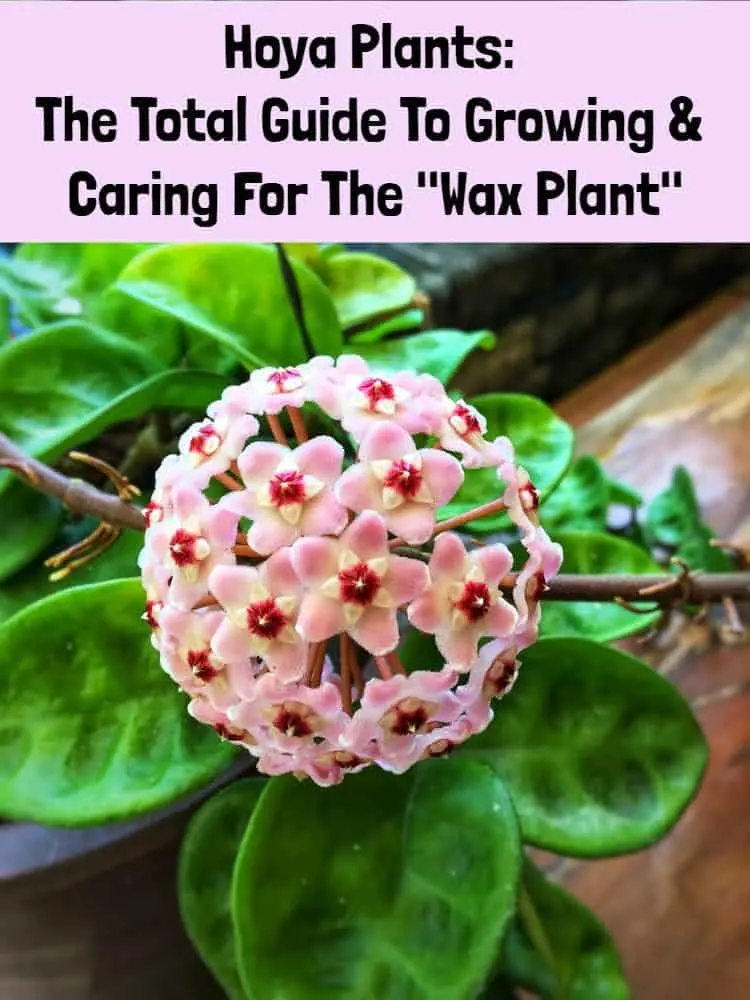

Get the famous Rural Sprout newsletter delivered to your inbox.
Including Sunday musings from our editor, Tracey, as well as “What’s Up Wednesday” our roundup of what’s in season and new article updates and alerts.

